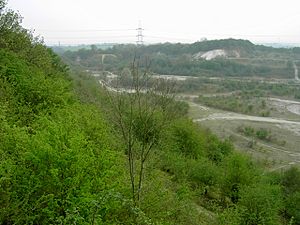Sundon Chalk Quarry facts for kids
| Site of Special Scientific Interest | |
 |
|
| Area of Search | Bedfordshire |
|---|---|
| Interest | Biological |
| Area | 26.2 hectares |
| Notification | 1989 |
| Location map | Magic Map |
Sundon Chalk Quarry is a very special nature area located in Upper Sundon, Bedfordshire. It is known as a Site of Special Scientific Interest (SSSI) because it is home to many rare and important plants and animals. This site covers about 26.2 hectares, which is roughly the size of 65 football fields! It was officially recognized as an SSSI in 1989. Even though it is privately owned, people are welcome to visit and explore its natural beauty.
Contents
What Makes Sundon Chalk Quarry Special?
Sundon Chalk Quarry is a unique place because it has many different types of natural environments, called habitats. These include wet areas called fens, small lakes, grassy areas on chalky soil, bushes, and woodlands. This mix of habitats allows many different species to live and thrive here.
A Look Back: The Quarry's History
This area was once a busy quarry where people dug out chalk and marl. These materials were used to make cement at the Sundon cement works, which operated from 1899 to 1976. After the cement works closed, the quarry was left to nature. Over time, it transformed into the rich wildlife haven we see today.
Amazing Plants of the Quarry
Sundon Chalk Quarry is famous for its interesting chalkland plants. Some of the special plants you might find here include:
- Ploughman’s spikenard: A plant with yellow flowers.
- Wild liquorice: A plant related to the liquorice used in sweets.
- Woolly thistle: A type of thistle with soft, woolly leaves.
The quarry also has what is probably the largest group of Chiltern gentian flowers in England. These beautiful purple flowers are quite rare, making their presence here very important.
Incredible Insects and Their Life Cycles
The quarry is a fantastic place for insects, with one of the most important collections of insect species in Bedfordshire.
- Dragonflies and Damselflies: You can find sixteen different kinds of dragonflies and damselflies here. Some rare ones include the scarce blue-tailed damselfly and the ruddy darter dragonfly. These are not often seen in Britain. The emerald damselfly and the red-eyed damselfly are also uncommon in Bedfordshire.
- Butterflies: There are twenty-one different types of butterflies, including the beautiful and uncommon Adonis blue butterfly.
- Beetles: The quarry is home to several uncommon beetles, such as Apion astragali. The young (larvae) of this beetle only eat the wild liquorice plant, which is also a rare plant in Britain. This shows how different species depend on each other.
Amphibians and Their Reproduction
The wet areas and lakes in the quarry are perfect for amphibians. You can often see different types of amphibians breeding here, meaning they lay their eggs and their young grow up in these waters.
- Common frog: A well-known amphibian found in many ponds.
- Smooth newt: A small newt that lives in ponds and on land.
- Great crested newt: A larger, protected newt that needs clean water to breed.
These amphibians regularly use the quarry's ponds for their life cycles, making it an important breeding ground for them.
Visiting Sundon Chalk Quarry
If you enjoy walking and exploring nature, the Chiltern Way footpath passes right through Sundon Chalk Quarry. You can access this path from Church Road. It's a great way to see the diverse habitats and wildlife that make this SSSI so special.

